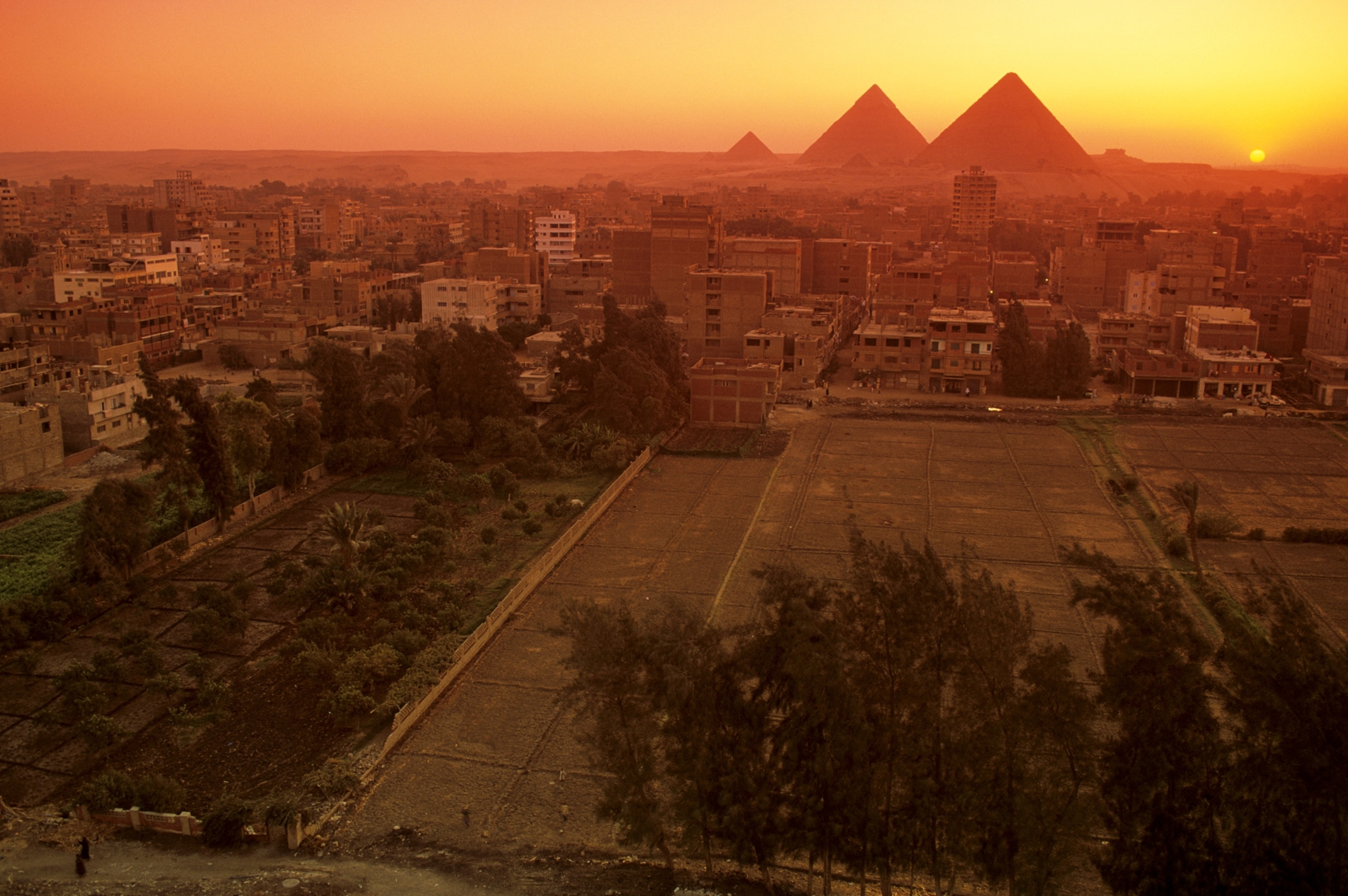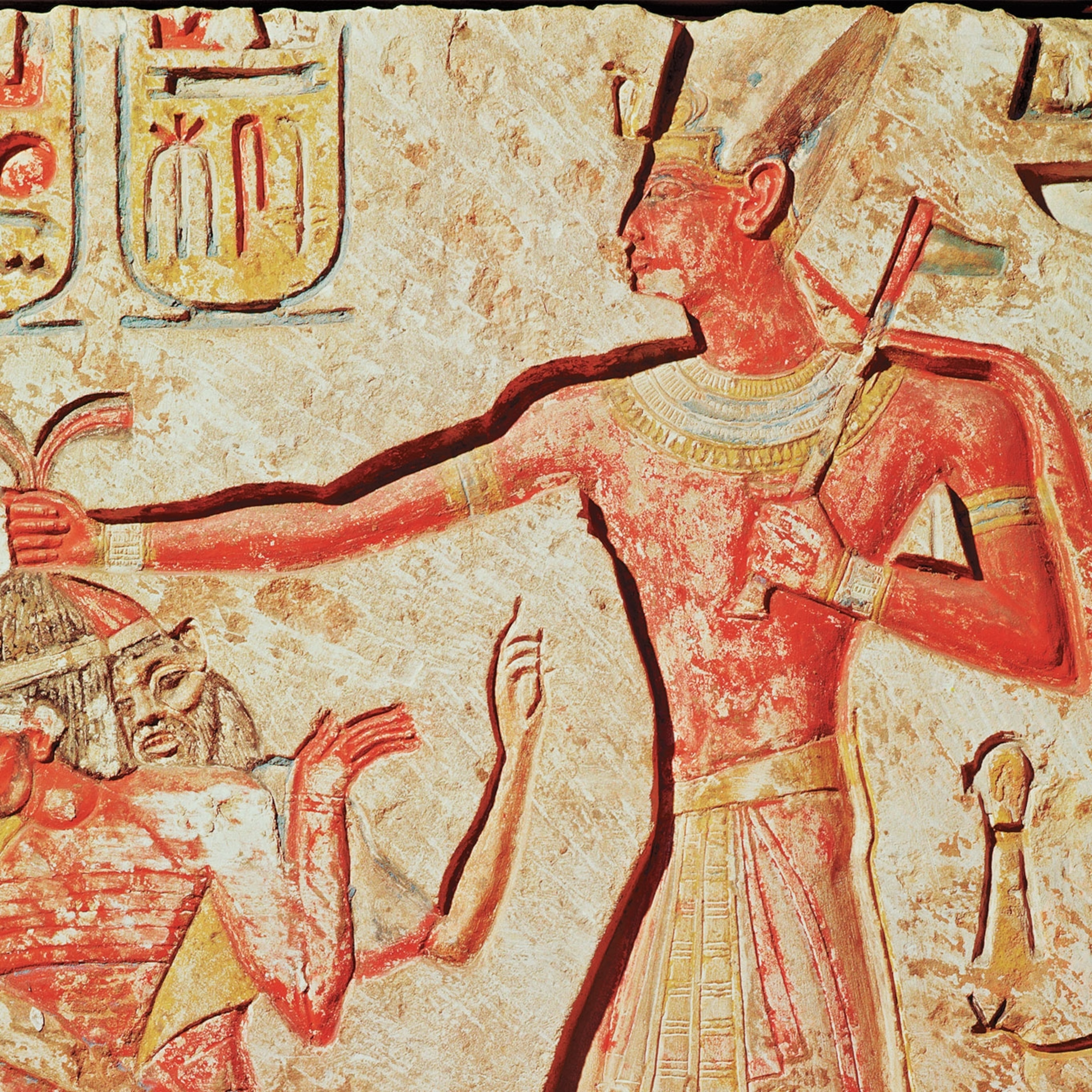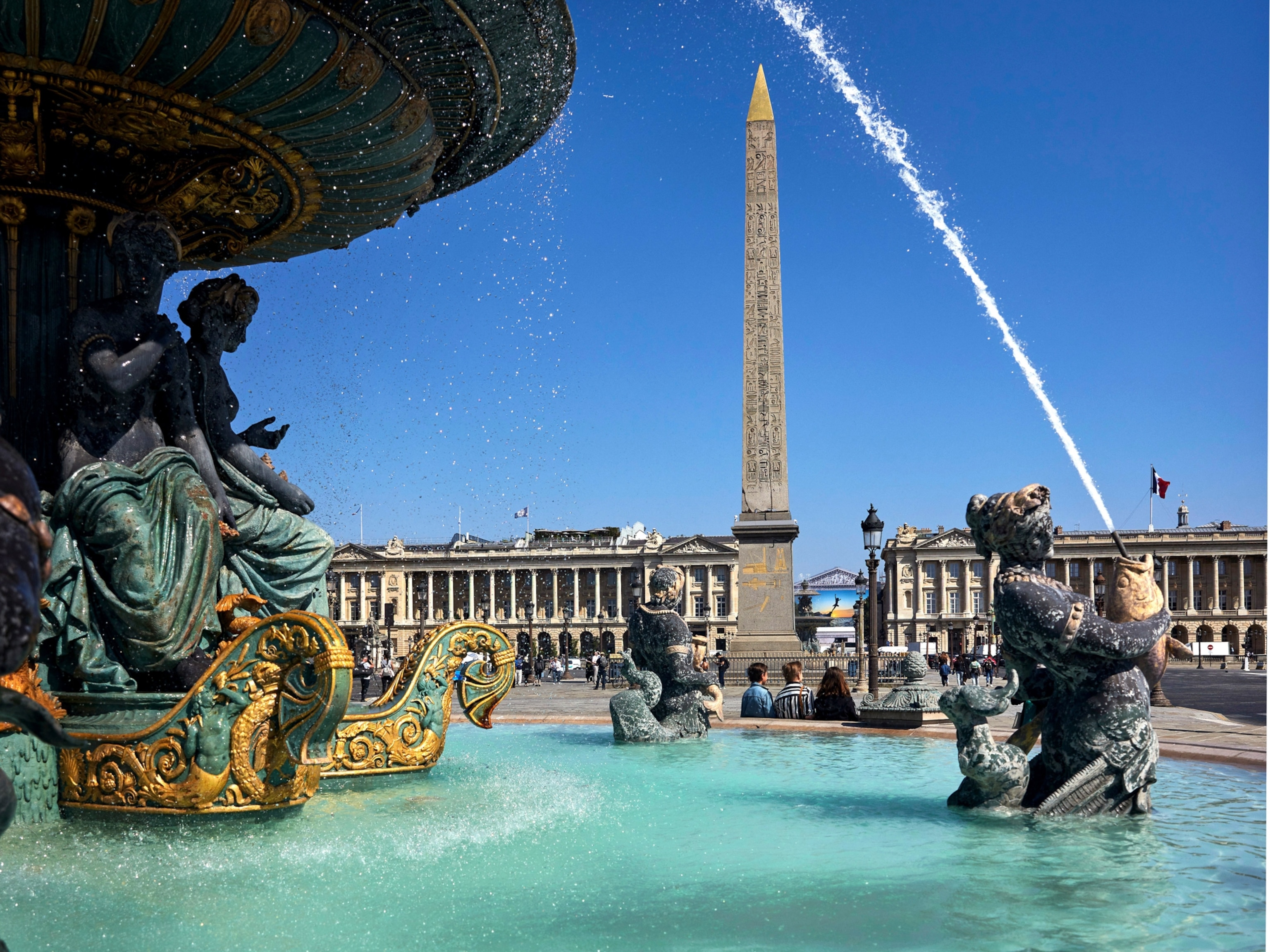How were the Pyramids of Giza built?
Egypt’s Pyramids of Giza were built to endure an eternity, but how remains one of the ancient world’s greatest mysteries. Here’s what archaeologists know.

The Pyramids of Giza, built to endure an eternity, have done just that. The monumental tombs are relics of Egypt’s Old Kingdom era and were constructed some 4,500 years ago.
Egypt’s pharaohs expected to become gods in the afterlife. To prepare for the next world they erected temples to the gods and massive pyramid tombs for themselves—filled with all the things each ruler would need to guide and sustain themselves in the next world.
Each of the three massive Egyptian pyramids is but one part of the Giza pyramid complex that includes a palace, temples, solar boat pits, and other features.
Here’s what to know about who built them, how they were built—and the treasures we’ve discovered inside.
When were the pyramids built, and who built them
Pharaoh Khufu was the first Egyptian king to commission a pyramid in Giza, a project he began in circa 2550 B.C. His Great Pyramid is the largest in Giza and originally towered some 481 feet (147 meters) above the plateau.
It’s a bit shorter now with its smooth casing stones long gone. Its estimated 2.3 million stone blocks each weigh an average of 2.5 to 15 tons.
Khufu’s son, Khafre, built the second valley temple at Giza, circa 2520 B.C. The Pyramid of Khafre, or mortuary temple, stands out on the landscape because it includes the Great Sphinx, a mysterious limestone monument with the body of a lion and the head of a pharaoh.
(These mighty pyramids were built by one of Africa’s earliest civilizations)
The Sphinx, which before the 1800s spent thousands of years buried in the sand with only its head visible, may stand sentinel for the pharaoh’s tomb complex, although there’s no definitive proof that he built it.
The third of the Giza Pyramids is considerably smaller than the first two—less than half their height at about 218 feet. Built by Khafre’s son Menkaure circa 2490 B.C. the pyramid’s elaborate complex includes two separate temples connected by a long causeway, and three individual queens’ pyramids.
(Explore the elaborate tomb of Nefertari—and see how ancient Egyptians buried their royals)
Menkaure’s chambers include niche decorations unique to Giza and a vaulted ceiling in his burial chamber itself. The pharaoh’s elaborate sarcophagus was lost at sea near Gibraltar in 1838.
How the Pyramids of Giza were built
The ancient engineering feats at Giza were so impressive that even today scientists and engineers can't be sure exactly how the pyramids were built. Yet they have learned much about the people who built them and the political power necessary to make it happen.
Archaeological sites across Egypt and records written on ancient papyri show that boatmen used the Nile River and a network of artificial waterways to bring materials to the Giza Plateau, including granite from Aswan quarries, copper cutting tools from the Sinai Peninsula, and timber from Lebanon. To sustain the workers, they also delivered cattle from farms near the Nile Delta.
(What it’s like to scuba dive under pyramids)
It’s likely that communities across Egypt contributed workers, as well as food and other essentials, for what became in some ways a national project to display the wealth and control of the ancient pharaohs.
It’s generally believed that the Egyptians moved massive stone blocks to the heights along large ramps, greased by water or wet clay, using a system of sledges, ropes, rollers, and levers. Some suggest exterior ramps either zig-zagged or spiraled around each pyramid, while a more controversial theory suggests internal ramps were used.
These secrets of the pyramids’ construction may lie below the surface. Perhaps as future imaging technology reveals the arrangements of blocks inside, they will provide a blueprint for how Egyptian builders created these timeless monuments.
(This ancient Egyptian left behind 4,500-year-old DNA. Researchers recreated his face.)

What’s inside the pyramids
If the pyramids helped to build ancient Egypt, they also preserved it. Giza allows us to explore a long-vanished world.
“Many people think of the site as just a cemetery in the modern sense, but it’s a lot more than that,” says Harvard University Egyptologist Peter Der Manuelian. “In these decorated tombs you have wonderful scenes of every aspect of life in ancient Egypt—so it's not just about how Egyptians died but how they lived.”
Tomb art includes depictions of ancient farmers working their fields and tending livestock, fishing and bird hunting, practicing carpentry, wearing costumes, and performing religious rituals and burial practices.
(Who was King Tut, the teen pharaoh who captivated the world?)
Inscriptions and texts also allow research into Egyptian grammar and language. “Almost any subject you want to study about Pharaonic civilization is available on the tomb walls at Giza,” Der Manuelian says.
Many of these unique resources are freely accessible to all at The Giza Project, an enormous collection of photographs, plans, drawings, manuscripts, object records, and expedition diaries from the world’s leading institutions, gathered together in an incredible online repository for Giza-related material.
This collection preserves paintings and inscriptions that have since faded away, captures artifacts that have been lost or destroyed, and unlocks tombs not accessible to the public.
(Here’s how ancient Egyptians packed food for the hereafter)
While nothing could ever replicate the experience of a personal visit to Giza, the reconstructions of GIZA 3D may be the closest you can get. Virtual visitors from anywhere in the world can wander the wonders of the plateau and take guided tours of pyramids, temples, and even tombs.
The Giza Plateau and its monuments
Pyramids were built with the afterlife in mind and symbolized a means by which the pharaoh might climb to the heavens. They may also evoke the original mound of land which rose from the sea at the world’s beginning, so the king might be similarly reborn.
All three pyramids were aligned to the compass points with uncanny accuracy, perhaps by using stars, or mapping shadows on key dates like the fall equinox.
(How cosmic rays helped find a tunnel in Egypt’s Great Pyramid.)
Debate continues about how, or if, the pyramids were precisely aligned with key stars. Theories of alignment with Orion’s Belt are dismissed by scientists—but popular among believers in alien builders. Mysterious shafts leading out of the King’s Chamber may have pointed to important stars, or simply brought fresh air.
Egyptians did use the Sun to arrange monuments at Giza; during the summer solstice it sets precisely between the pyramids of Khufu and Khafre, as seen from the Great Sphinx.
Egypt’s kings were entombed in bench-shaped mounds until about 2780 B.C.E when Imhotep created the step pyramid of Djoser by stacking six flat-roofed mounds atop one another.
(This Egyptian queen’s tomb lay untouched for more than 4,000 years)
Snefru, founder of the Fourth Dynasty (2680–2560 BCE), took pyramid building to new heights. He built a step pyramid at Meidum then filled in the steps to smooth its shape.
At Dahshur he attempted a pyramid with four triangular walls rising to a center point. During construction it became unstable so builders eased its angle—creating the Bent Pyramid. Snefru’s third Red Pyramid stands as a squatty success with its low 43-degree angle.
This hard-earned experience in engineering and logistics had an impact on Snefru’s son Khufu—and the most famous pyramid of all. “It’s almost like Snefru did all the R&D work,” archaeologist Mark Lehner notes. “Khufu was able to take full advantage of all this and build the Great Pyramid.”
(The last missing tomb from this wealthy Egyptian dynasty has been found)
What archaeology reveals about ancient Egyptian builders
At Giza’s “Lost City of the Pyramids,” exploring how the builders lived has revealed much about how they made the pyramids.
Lehner says a complex of long barracks, separated by wide paved streets, was thousands of years before its time. “The experience of being in this sort of ancient hotel must have been radically different from life in a village back home. And we have evidence that people rotated in an out, so it really was a socializing experience.”
(The true story of the ‘lost city’ made famous by Indiana Jones)
The city also housed a community of craftworkers, those that fed, sheltered, and clothed the pyramid work force, made their tools, and otherwise supported the gargantuan effort.
No doubt parts of pyramid building were hard, but evidence from the city and its ancient garbage shows that workers were valued. They enjoyed medical care, plentiful bread and beer, prime beef, and other goods which were sourced across Egypt, as were the materials to build the monuments.
All this required a massive infrastructure, which is how the pyramids actually helped to build Egypt in the ancient world.
(How a single battle—and one young pharaoh—turned Egypt into a superpower)
Farms and ranches sprouted in Middle Egypt and the Nile Delta. Trade and supply routes brought copper from Sinai and cedar from Lebanon. As described in an ancient diary fine casing stones were floated down the river from the quarry at Tura, through seasonal canals to the edge of the plateau itself.
After the peak of pyramid building passed, this Egyptian legacy lasted. “What happened,” Lehner says, “is that all the infrastructure that went into supporting this pyramid building became more important in its own right than building giant pyramids. The real advance was in organizing people.”
What are we still discovering about the pyramids?
The pyramids of Giza still hold plenty of secrets. While scientists continue to make new discoveries, many of them raise new questions.
The Heritage Innovation Preservation Institute’s ScanPyramids project, an international team under the authority of Egypt’s Ministry of Antiquities, has been using modern technology to delve inside the pyramids since 2015 without setting foot inside.
(Scientists find evidence of ancient waterway beside Egypt’s pyramids)
Advances in high-energy particle physics have allowed them to use cosmic rays to uncover various empty spaces that had been hidden for 4,500 years—including one void that rivals the size of the pyramid’s Grand Gallery and another passage, dubbed the North Face Corridor, to the Pyramid of Khufu.
(Is there really a secret city under Egypt’s pyramids?)
It’s unclear if anything is inside these spaces, but most experts believe they have no ritual significance. Instead, they were likely used during pyramid construction, a carefully engineered system to distribute the weight and stress that have enabled the Pyramids of Giza to stand the test of time.








